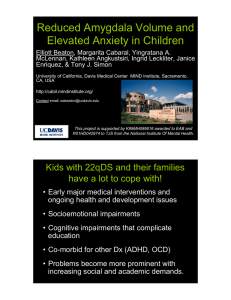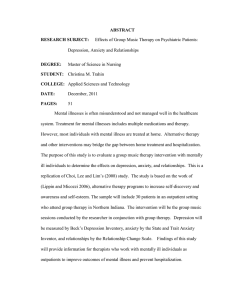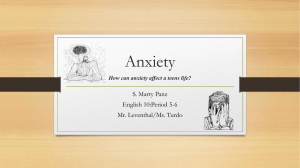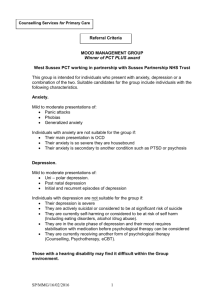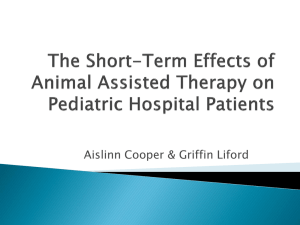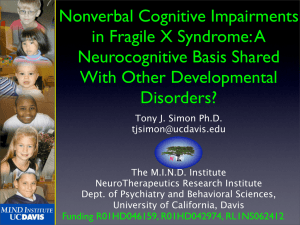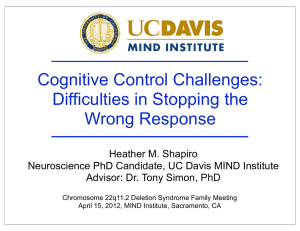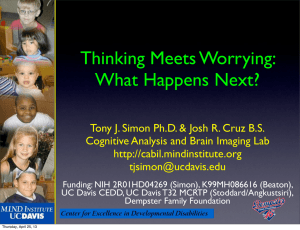Stress, anxiety, and depression in care-givers of children with chromosome 22q11.2 deletion syndrome
advertisement
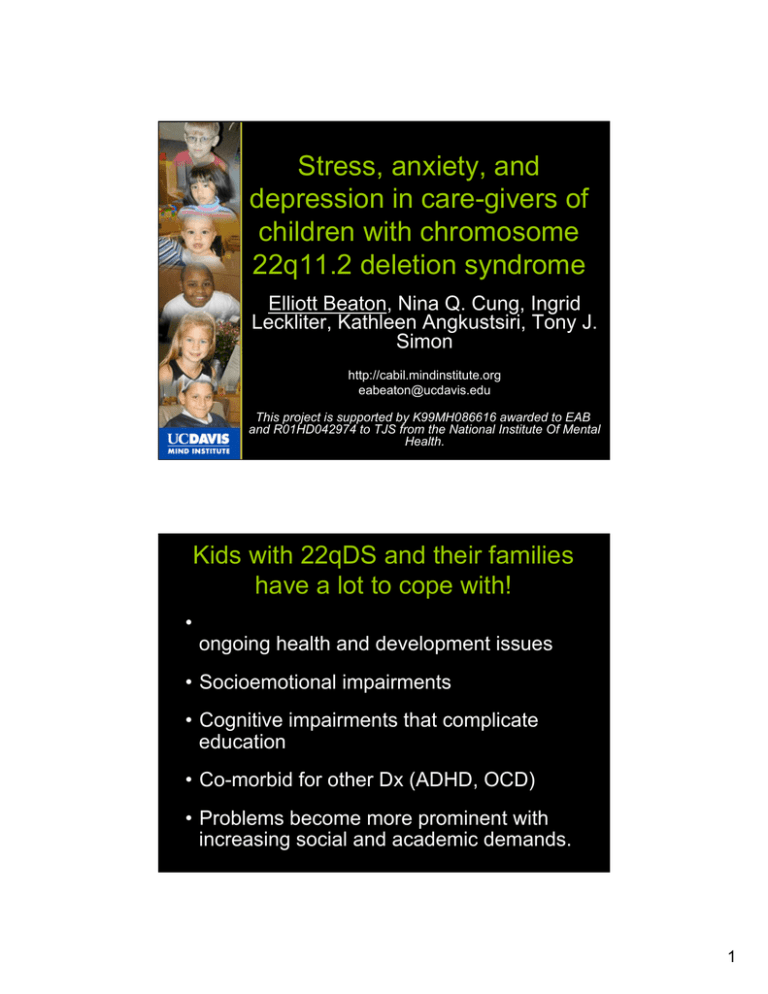
Stress, anxiety, and depression in care-givers of children with chromosome 22q11.2 deletion syndrome Elliott Beaton, Nina Q. Cung, Ingrid Leckliter, Kathleen Angkustsiri, Tony J. Simon http://cabil.mindinstitute.org eabeaton@ucdavis.edu This project is supported by K99MH086616 awarded to EAB and R01HD042974 to TJS from the National Institute Of Mental Health. Kids with 22qDS and their families have a lot to cope with! • Early major medical interventions and ongoing health and development issues • Socioemotional impairments • Cognitive impairments that complicate education • Co-morbid for other Dx (ADHD, OCD) • Problems become more prominent with increasing social and academic demands. 1 Stress and Chromosome 22q11.2DS Stress and allostatic load in 22qDS likely results from a multivariate and reciprocal interaction of: – Atypical brain development – Early traumatic experiences – Medical, behavioral, cognitive, and socioemotional challenges associated with the syndrome borne by the children and their families – Genetically derived temperament, coping capacity, and resilience Elevated anxiety in 22q11.2DS vs. TD kids 22q (n = 42) 65 p = 0.008 p = 0.008 p = 0.0001 p = 0.004 p = 0.046 p = 0.04 p = 0.03 NS, p = 0.06 50 45 40 35 A Ph nx ys ie ic ty al Sy m pt om Te s ns e/ Re stl es s So m at iz at H io ar n m A vo id an ce Pe rf ec tio ni A sm nx io us C op in So g ci al H A um nx ili ie at ty io n /R Pe ej rf ec or tio m an n ce A Se nx pa ie ra ty tio n A nx A ie nx ty ie ty D iso rd er 30 To ta l Mean Scores (+/-SEM) 60 55 p = 0.004 TD (n = 34) 2 Elevated depression in 22q11.2DS vs. TD kids 22q (n =39) TD ( n = 32) 60 p = 0.04 55 p = 0.01 50 45 N eg at iv e Se lfes te em nh ed on ia A s In ef fe ct iv en es s Pr ob le m oo d M In te rp er so na l eg at iv e N D ep re ss io n 40 To ta l Mean Score (+/-SEM) 65 Anxiety has measurable and important behavioral implications for kids with 22q11.2DS. 3 Separation anxiety does not abate in 22q (p = 0.015) Beaton et al. (ongoing study) Understanding the child’s ecology… • • • • Socioeconomics School environment and community supports Environmental health Community factors (safety and crime, access to health care, social support, urbanization) • Cultural factors, language, and racism • Parental stress and mental health 4 Understanding the child’s ecology… • • • • Socioeconomics School environment and community supports Environmental health Community factors (safety and crime, access to health care, social support, urbanization) • Cultural factors, language, and racism • Parental stress and mental health Maternal Depression (BDI) 22Q moms n = 17 Beaton et al. (ongoing study) 5 Maternal Quality-of-Life Scale Beaton et al. (ongoing study) Negative and Positive Life Events Over the Past Year Beaton et al. (ongoing study) 6 Maternal Depression, Anxiety, and Stress 22q Mothers (n=17) TD Mothers (n = 5) Beaton et al. (ongoing study) Maternal Depression, Anxiety, and Stress 22q Mothers (n=17) TD Mothers (n = 5) Ss 001 Beaton et al. (ongoing study) 7 Av oi da nc e Pe rf e ct io ni sm An xi ou s C op in g So ci al A H nx um ie ili a ty tio n R ej ec Pe t io rf o n rm an ce Fe ar Se s pe ra ti o An n/ Pa xi et ni y c D is or de rI nd ex M AS C To ta l to no m ic 95 ar m at ic /A u MASC t-scores So m pt om s es t le ss at ic /A ut on om H ic ar m Av oi da nc e Pe rf e ct io ni sm An xi ou s C op in g So ci al A H nx um ie ili a ty tio n R ej ec Pe t io rf o n rm an ce Fe ar Se s pe ra ti o An n/ Pa xi et ni y c D is or de rI nd ex M AS C To ta l Te ns e/ R ym Ph ys ic al S MASC t-scores 95 H So m pt om s es t le ss ym Te ns e/ R Ph ys ic al S Multidimensional Anxiety Scale for Children 100 90 Ss 001 Ss 001 22q (n = 51 no Ss 001) 22q (n = 51 no Ss 001) TD (n = 41) 85 80 75 70 65 60 55 50 45 40 35 30 25 Multidimensional Anxiety Scale for Children 100 90 TD (n = 41) 85 80 75 70 65 60 55 50 45 40 35 30 25 8 N eg at ive S ni a el fE st ee m An he do ne ss Ss 001 N eg at ive S s el fE st ee m ni a ne ss An he do In ef fe ct iv e I oo d D lP ro bl em eg at ive M In te rp er so na N To ta lC Ss 001 In ef fe ct iv e s oo d I 65 lP ro bl em eg at ive M D CDI t-scores 65 In te rp er so na N To ta lC CDI t-scores Children’s Depression Scale 70 22q (n = 47) TD (n = 39) 60 55 50 45 40 35 30 Children’s Depression Scale 70 22q (n = 47) TD (n = 39) 60 55 50 45 40 35 30 9 SUMMARY – The Child’s Ecology • As a group, children with 22q11.2DS report greater levels of anxiety and depression vs. TD • Parental stress, anxiety, and depression is variable and should be addressed to improve QOL for parents but also but may affect child health • A family- and community- focused perspective (eg. parental mental health) needs to be added Elliott Beaton is joining the Department of Psychology faculty at the University of New Orleans We will be continuing our research on stress, development and health in children with 22q11.2DS at the MIND Institute and at the: Stress, Cognition, and Affective Neuroscience (SCAN) Laboratory http://psyc.uno.edu/ 10 Thank you. Cognitive Analysis and Brain Imaging Laboratory ► Dr. Tony Simon (Primary Mentor) ► Dr. Flora Tassone (Genetics) ► Dr. Kathy Angkustsiri (Pediatrics) ► Dr. Ingrid Leckliter (Clinical Psych) ► Nina Cung ► Yingratana (Bella) McLennan, B.S. ► Margie Cabaral, B.S. K99 Mentorship ► Dr. Cameron Carter ► Dr. Bruce McEwen ► Dr. Louis Schmidt ► Dr. Blythe Corbett ► Dr. Robert McCarron ► Dr. Richard Maddock Most importantly, thank you to the participants and their families. This project is supported by K99MH086616 awarded to EAB and R01HD042974 to TJS from the National Institute Of Mental Health. 11
